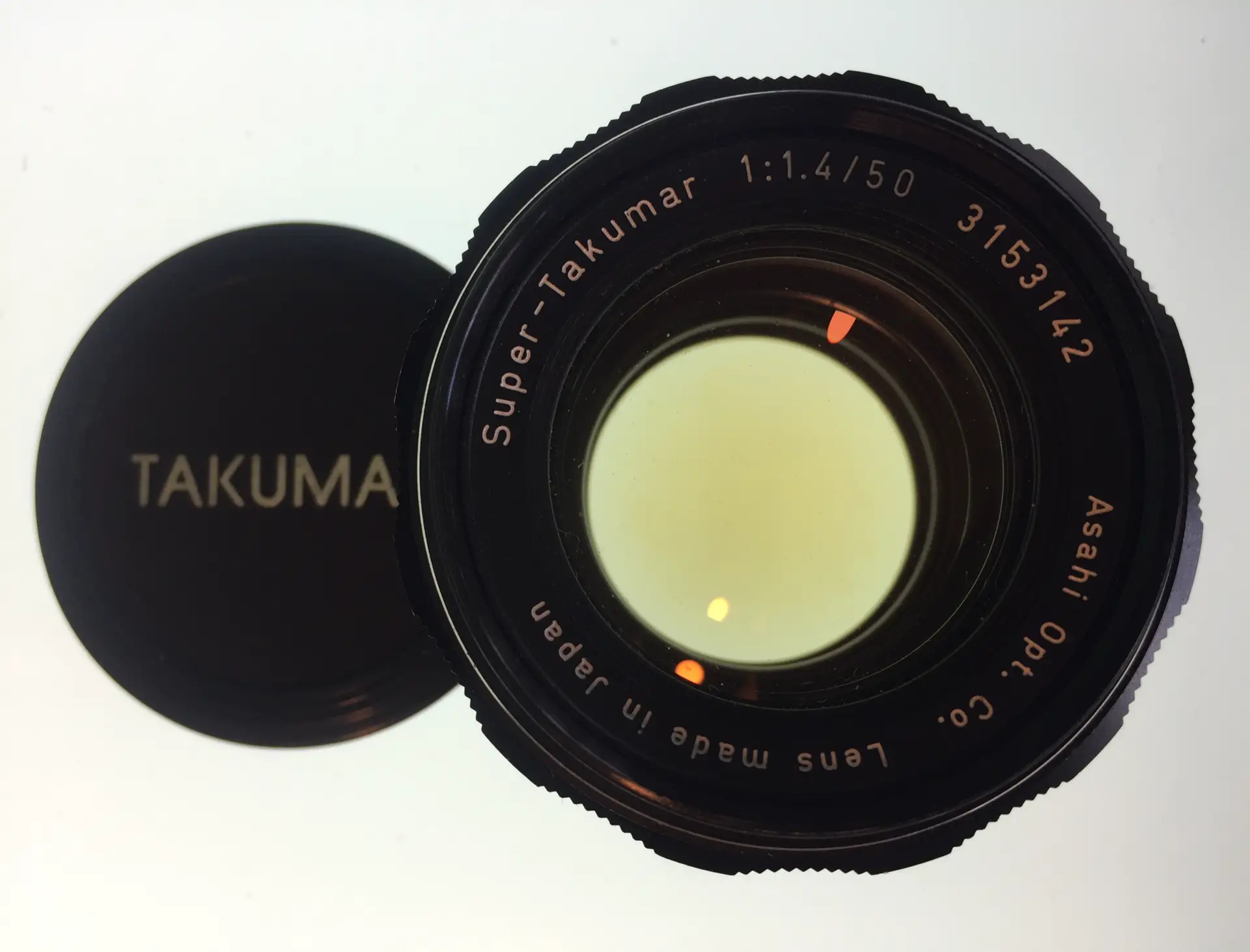Photographers who remember the Petula Clark 1967 hit single that’s paraphrased in the title will also probably know what it’s talking about! Regardless of how much one might love the above highly respected lens (and others of its era), try to resist sleeping with them under one’s pillow! You may also want to avoid hanging them on cameras around your neck for extended periods.
They’re radioactive. And I thought it would be good to share this story with the growing band of younger photographers who are even now discovering vintage camera equipment.
That Lovely Yellow Glass
The above lens is an excellent Pentax Super-Takumar 1:1.4/50. I photographed it on a light table to show off its lovely yellow glass. The color comes from radioactive thorium-oxide, which some manufacturers used in some lenses through the 1940s, 50s and 60s. This “doping” increased the refractive index of the glass, reduced chromatic aberration, and allowed manufacturers to make smaller lenses. The thorium is in the glass… not on it. And over time, radioactive decay turns the glass yellow.
Such lenses are still fine for photography (and can even add a little yellow filtering, when desired). My Pentax lens is a well-known victim. Another, is the highly respected Nikkor AI 35mm 1:1.4. My copy, though, hasn’t turned yellow (yet). Both lenses also happen to be “fast” 1.4 glass, which the doping helped to make more compact. (I’ve heard that Canon’s FD 50mm f/1.2 is also radioactive, but my copy of its FL 55mm f/1.2 cousin doesn’t appear to be.)
Are they Dangerous?
The above Imaging-Resource link tries to put their radioactivity in perspective, by pointing out that most of the lenses’ rads exit safely through their fronts (which would also prevent film fogging). But this informative video warns that this may not always be true (and demonstrates that the lenses can affect digital sensors).
Both sources, though, agree that a user’s potential exposure would be fairly minimal… unless one holds a camera near their face for extended periods. Here’s how Imaging Resource quantifies possible dosage levels:
“If you pressed the front element of the lens up to your body for an hour, it’d be about the same as an x-ray. So as long as you’re not sleeping using your camera bag as a pillow, you’re probably fine.”
Other Manufacturers
Pentax, Nikon and Canon aren’t the only manufacturers to use thorium-oxide. The above video lists others. And here’s an even more extensive list of Geiger-tested lenses. It claims that Kodak was one of the greatest adopters– with thorium used in some Pony, Signet, Instamatic and Ektar lenses (especially Aero-Ektars). (If readers know of any other manufacturers and lenses, please tell us in the comments.)
But you don’t necessarily need a Geiger Counter to determine if a vintage lens is radioactive. Just look through it for that lovely yellow color. And as Pet Clark might say if she sang about photography today: “Don’t Sleep with Yellow Lenses, Darlin’!”
–Dave Powell is a Westford, Mass., writer and avid amateur photographer.
Share this post:









Comments
Bob Janes on Don’t Sleep with Yellow Lenses, Darlin’
Comment posted: 17/05/2023
Thorium eyepiece glass would not be a good idea, as you would be putting a radiation sensitive organ close to the surface of the radioactive glass for a fair time, but I don't think any camera eyepieces were ever made with that glass... (possibly some military sights - governments seem to have been a bit blaze with the long-term health of their soldiers sometimes).
I had read somewhere that the yellowing/browning was due to decay into iodine salts, but I can't find my sources, so I may have speculated that up at some time in the past.
In any case, the yellowing/browning is a product of radioactive decay, so a brown-ish lens should (theoretically?) be less radioactive than it was at the time of manufacture.
Supposedly if a concave lens goes yellow/brown it should be darker towards the edges... a sort of STF effect?
Comment posted: 17/05/2023
Comment posted: 17/05/2023
Comment posted: 17/05/2023
Comment posted: 17/05/2023
Comment posted: 17/05/2023
Comment posted: 17/05/2023
Gil Aegerter on Don’t Sleep with Yellow Lenses, Darlin’
Comment posted: 17/05/2023
Comment posted: 17/05/2023
Nikojorj on Don’t Sleep with Yellow Lenses, Darlin’
Comment posted: 17/05/2023
https://web.archive.org/web/20230408063209/https://www.imaging-resource.com/news/2013/05/06/are-your-old-lenses-radioactive
And if you want a bit more information you can go to https://camerapedia.fandom.com/wiki/Radioactive_lenses with a list or such lenses, and https://xkcd.com/radiation/ gives plenty of comparisons and ordrers of magnitude (it's often annuals doses though).
For the yellow in the lens, I've often heard it can be mitigated by letting the lens sitting in the sun (or other UV light).
Comment posted: 17/05/2023
Gil Aegerter on Don’t Sleep with Yellow Lenses, Darlin’
Comment posted: 17/05/2023
Comment posted: 17/05/2023
John Murch on Don’t Sleep with Yellow Lenses, Darlin’
Comment posted: 18/05/2023
Comment posted: 18/05/2023
Geoff Chaplin on Don’t Sleep with Yellow Lenses, Darlin’
Comment posted: 18/05/2023
Comment posted: 18/05/2023
Ibraar Hussain on Don’t Sleep with Yellow Lenses, Darlin’
Comment posted: 18/05/2023
I’m curious - does the yellow tint increase contrast as a light yellow would ?
Comment posted: 18/05/2023
Joseph Irvin on Don’t Sleep with Yellow Lenses, Darlin’
Comment posted: 18/05/2023
Comment posted: 18/05/2023
Kodachromeguy on Don’t Sleep with Yellow Lenses, Darlin’
Comment posted: 19/05/2023
Comment posted: 19/05/2023
Joe Van Cleave on Don’t Sleep with Yellow Lenses, Darlin’
Comment posted: 20/05/2023
Comment posted: 20/05/2023
Dirk Saeger on Don’t Sleep with Yellow Lenses, Darlin’
Comment posted: 22/06/2023
So: Don't lick your lens and don't inhale over its surface.
Otherwise have lots of fun with these.
Greets
Dirk
Comment posted: 22/06/2023